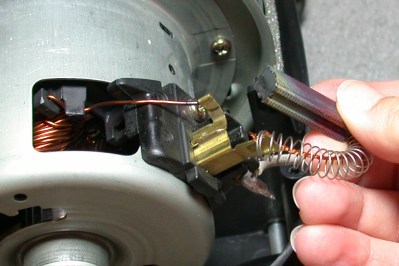
You own it, you should be able to fix it. So much equipment on sale today has either been designed to be impossible to maintain, unnecessarily too complex to maintain, maintainable only with specialist tooling only available to authorised service agents, or with no repair parts availability. It’s a hot-button issue in an age when sustainability is a global concern, so legislators and regulators worldwide now finally have it in their sights after years of inaction and it’s become a buzzword. But what exactly is the right to repair, and what do we want it to be?
Is It Designed For Repair?

The first question to consider is this: does it matter whether or not you have the right to repair something, if it’s designed specifically with lack of repairability in mind? Consider a typical domestic pod coffeemaker such as a Tassimo or similar: despite being physically quite a simple device, it is designed to be especially complex to dismantle and reassemble. You just can’t get into it when something goes wrong.
Should it be the preserve of regulators to require design for easy repair? We think so. There are other forces working on the designers of home appliances; design-for-manufacture considerations and exterior appearance concerns directly affect the firm’s bottom line, while the end users’ repair experience is often at the bottom of the list, even though the benefit at a national level is obvious. That’s what laws are for.
Are Other Laws Being Misused To Curtail Repair?

In many cases there’s no such thing as a lack of a right to repair. Oxford Hackspace’s coffee machine may have been difficult to repair when it broke, but I had every legal right to do so.
Turn to the poster child/villain of many right-to-repair stories: John Deere. Because the machine itself is designed to be worked on, it seems obvious that a farmer should be able to wrench on their tractor.
Here, Deere turned to the DMCA, a piece of 1990s legislation born of music industry panic over piracy, that sought to prohibit the circumvention of copy protection mechanisms. Similar to the methods used to neuter refilled printer ink cartridges, Deere tied a software component that had to be linked to and authorised by a Deere computer. While the farmer could repair their tractor, it would no longer work after an unauthorised repair. Only Deere or their agents could perform the software portion of the repair, and circumventing it would fall foul of the DMCA. Should regulators have the power to prohibit the curtailment of repairability by tying the process into other legislation? We think so.
Is Needless Complexity Hindering Repairability?
It’s all very well having something designed for repair and unencumbered by legal impediments, but there are other ways that a manufacturer can hinder the repairability of their products. When an otherwise simple product is made unnecessarily complex it both increases the likelihood of a fault and increases the cost of a repair, in the interests of the manufacturer who wants to sell a new product but not in those of the consumer. Those Deere tractor parts yet again provide an example, in which an otherwise simple part carries a chip; where previously there was only a simple mechanical or hydraulic part there is now an unnecessary electronic accoutrement.
Anybody who has maintained motor vehicles made in the 1980s alongside those made a decade ago will understand this; where the former simply has a bulb and a switch for its lighting the latter now does exactly the same task with microcontrollers in both switch and lamp. Those prepared to defend this practice with a description of the virtues of a CAN bus should reflect on the current chip shortage and its causes in the unnecessary proliferation of automotive microcontrollers. Should regulators be asking questions about needless product complexity in order to hinder repairability? We think so.
Are Small parts Being Hidden In Modules?

Given a product that’s simple enough to repair and easy enough to get into, we turn to the question of parts availability. It’s a favourite trick of domestic appliance manufacturers, to render their older products obsolete by taking spare parts ranges off the market, and this practice has come under the spotlight with the EU’s approach to the issue.
They require the parts for example for a washing machine to be available for sale for a decade after it was made, but it’s worth considering for a moment: just what is a part? Common sense dictates that any part which has the capability to fail should be available, but that’s a definition which is open to interpretation.
Picture for a minute a motor in which the brushes have failed, you might expect to go to the parts store and buy a set of replacement brushes. But an unscrupulous manufacturer can designate the motor as the part rather than the brushes, meaning that a few-dollar part becomes a many-dollar part. Other examples of small consumable parts which are subsumed into much more expensive parts assemblies include bearings which can not be replaced on their own, or seals. Should regulators have the power to require that replaceable wear items be made available separately instead as only incorporated in larger assemblies? We think so.
Is There Enough Information To Repair It?
Finally, it’s understood that many devices today are by necessity computerised. We may have complained about unnecessary overuse of microcontrollers in motor vehicles for example, but it’s undeniable that there are many functions in a modern car that are only made possible by the use of a microcontroller. SInce their diagnostic functions form an essential part of their repair it is essential that they do not present an opportunity to restrict repairability by restricting access to information, software, protocols, and error codes. American farmers are having to resort to Easter European software piracy to gain access to the systems on their Deere tractors, and even though car owners the world over can plug in an OBD-2 dongle there is still much of the information it can access that remains proprietary. Should there be a requirement from regulators that documents, diagnostic protocols and software be made available to all? We think so.
This article has come close to a manifesto in its stating of the key points we think should be considered when evaluating a right-to-repair proposal, but we think that it’s important to spell them out. And fortunately, we’re not alone. Following the EU’s landmark right-to-repair guidelines, the US Federal Trade Commission announced its intention to more actively pursue repair laws that are already on the books.
It’s inevitable that there will continue to be powerful industry lobbies pushing for them to be watered down, against the will of the consumer, so the greater the number of people who have a chance to discuss them, the better. Did we think of everything in our exploration of the topic? Please let us know in the comments.
0 Commentaires